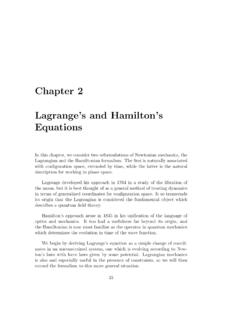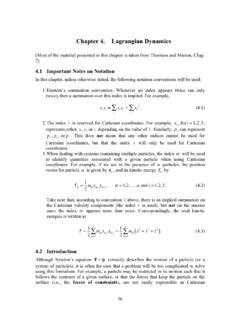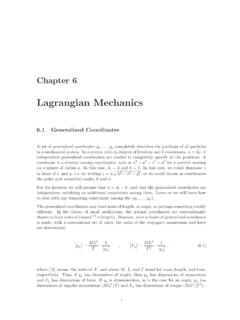Transcription of 8.09(F14) Chapter 4: Canonical Transformations, Hamilton ...
1 Chapter 4 Canonical Transformations, Hamilton - jacobi equations , andAction-Angle VariablesWe ve made good use of the Lagrangian formalism. Here we ll study dynamics with theHamiltonian formalism. Problems can be greatly simplified by a good choice of generalizedcoordinates. How far can we push this?Example: Let us imagine that we find coordinatesqithat are all cyclic. Thenp i= 0, sopi= iare all constant. IfHis conserved, then:H=H( 1,.., n)( )is also constant in time. In such a case the remaining equations of motion: Hq i== i( )= i qi it+ i( ) All coordinates are linear in time and the motion becomes very might imagine searching for a variable transformation to make as many coordinates aspossible cyclic.
2 Before proceeding along this path, we must see what transformations Generating Functions for Canonical Transforma-tionsRecall the the Euler- lagrange equations are invariant when:60 Chapter 4. Canonical TRANSFORMATIONS, Hamilton -JACOBIEQUATIONS, AND ACTION-ANGLE VARIABLES a point transformation occursQ=Q(q,t) withL[q,t] =L [Q,t];dF[q,t] a total derivative is summed to the LagrangianL =L+.dtForHwe consider point transformations in phase space:Qi=Qi(q,p,t)andPi=Pi(q,p,t),( )where the Hamilton s equations for the evolution of the Canonical variables (q,p) are satisfied: Hq i= Handp i= pi .( ) qiGenerally, not all transformations preserve the equations of motion. However, the trans-formation iscanonicalif there exists a new Hamiltonian:K=K(Q,P,t),( )where K Qi= K andPi= Pi.
3 ( ) QiFor notational purposes let repeated indices be summed over s principle can be written as: t2 (piq i H(q,p,t))dt= 0,( )t1or in the new Hamiltonian as:t2 (PiQit1 K(Q,P,)t)dt= 0.( )For the Eq.( ) to imply Eq.( ), then we need: (piq i H) =PiQi K+F.( ) SinceFis a total derivative and the ends of the path are fixed: q|t2= 0and p|t2tt1t1= 0 F|2t1= 0( )There are a few things to be said about transformations and . If = 1 then the transformation iscanonical, which is what we will study. If 6= 1 then the transformation isextended Canonical , and the results from = 1 canbe recovered by 4. Canonical TRANSFORMATIONS, Hamilton -JACOBIEQUATIONS, AND ACTION-ANGLE VARIABLES IfQi=Qi(q,p) andPi=Pi(q,p) without explicit dependence on time, then thetransformation isrestricted will always take transformationsQi=Qi(q,p,t) andPi=Pi(q,p,t) to be invertiblein any of the Canonical variables.
4 IfFdepends on a mix of old and new phase space variables,it is called agenerating functionof the Canonical transformation . There are four importantcases of us takeF=F1(q,Q,t)( )where the old coordinatesqiand the new coordinatesQiare independent. Then: Fpiq i 1H=PiQi K+F1=PiQi K+ F1+ t F1q i+ qi Qi( ) Qi from this we see thatPiQicancels and equating the terms with aq i, aQiand theremaining terms gives: F1pi= F,Pi= Qi 1 F1andK=H+ Qi,( ) twhich gives us formula for a transformation :pi=pi(q,Q,t)andPi=Pi(q,Q, t)( )and connectsKto an : ifQF1= ,( )qthen: F1p=Q= q FandP=q2 11= Q.( )qWriting the new coordinates as function of the old ones yieldsQ=pq21andP=( )qExample: Given the transformationsQ= ln(pqandq)P= (2p+ 12),( )q62 Chapter 4.
5 Canonical TRANSFORMATIONS, Hamilton -JACOBIEQUATIONS, AND ACTION-ANGLE VARIABLESwe can prove they are Canonical by finding a corresponding generating function. Weknow: F1=p=qeQ,( ) qwhich gives usF1= qeQq2dq+g(Q) =eQ+g(Q),( )2and FP= 1q2= Q dgeQ2 q=dQ (2p+ 12)q=q (2+ 12)eQ g(Q) =eQ.( )ThusF1is given by:F1=(q2+ 1)eQ.( ) :F=F2(q,P,t) QiPi( )where we wish to treat the old coordinatesqiand new momentaPias independentvariables. Then: F q ipi H=QiPi 2K+F2 QiPi QiPi= QiPi K+ F2+ t F2q i+ qi Pi( ) PiThis corresponds to F2pi= F2;Qi= qi F2andK=H+ Pi.( ) could also takeF=F3(p,Q,t) +qipi( )with the new coordinatesQiand the old momentapias independent we could takeF=F4(p,P,t) +qipi QiPi( )with the old momentapiand new momentaPias independent can be summarized in the table 4.
6 Canonical TRANSFORMATIONS, Hamilton -JACOBIEQUATIONS, AND ACTION-ANGLE VARIABLESF unctionTransformationsSimplest caseF1(q,Q,t) F1pi= F,Pi= qi 1 QiF1=qiQiQi=pi,Pi= qiF2(q,P,t) F2pi= F2,Qi= qi PiF2=qiPiQi=qi,Pi=piF3(p,Q,t) Fqi= 3 F,Pi= pi 3 QiF3=piQiQi= qi,Pi= piF4(p,P,t) Fqi= 4 F4,Qi= pi PiF4=piPiQi=pi,Pi= qiThe simplest case of the 2nd(F2) transformation is just an identity transformation . For anyof theseFicases we also have: FiK=H+.( ) tIfFiis independent of time then this impliesK=H( )Mixed cases may also occur when more than two old Canonical coordinates are present. (Inthis Chapter we will be using Einstein s repeated index notation for implicit summation,unless otherwise stated.)Example: considerF2=fi(q,t)Pi( )for some functionsfiwherei {1.}
7 ,n}. Then F2Qi==fi(q,t)( ) Piis a coordinate point transformation . It is Canonical with fipi=Pj,( ) qjwhich can be inverted to getPj=Pj(q,p,t).Example: Consider the harmonic oscillator:p2H=kq2+2mwherek=m 2( )264 Chapter 4. Canonical TRANSFORMATIONS, Hamilton -JACOBIEQUATIONS, AND ACTION-ANGLE VARIABLESLet us try the transformation :p= 2mPcos(Q)( ) q= m 2mPsin(Q)for constant. Then:K=H=P 2(cos2(Q) + sin2(Q))=P 2,( )so the new momentumEP=( ) 2is just proportional to the energy, whileQis a cyclic this transformation Canonical ? We can find a generating functionF=F1(q,Q) bydividing the old variables:p=m cot(Q).( )qThis gives us: F1p=1F q 1= p(q,Q)dq+g(Q) =m q2cot(Q) +g(Q)( )2 FP= 1m q2= Qdg2 sin2(Q) dQSetting:dg2= 0dQ q2P=sin2(Q),( )m which tells us the transformation is Canonical if =.
8 This means:EP=( ) By Hamilton s equations Eq.( ): K Q== P Q= t+ .( )Putting this altogether, this gives the familiar results:q= 2 Esin( t+ )( )m 2p= 2mEcos( t+ ).Lets record for future use our final Canonical transformation here:q= 2 Psin(Q),p= m 2m Pcos(Q).So far, a transformationQ=Q(q,p,t) andP=P(q,p,t) is Canonical if we can find agenerating functionF. This involves integration, which could be complicated, so it wouldbe nice to have a test that only involves differentiation. There is one!65 Chapter 4. Canonical TRANSFORMATIONS, Hamilton -JACOBIEQUATIONS, AND ACTION-ANGLE Poisson Brackets and the Symplectic ConditionIn Classical Mechanics II ( ) thePoisson bracketof the quantitiesuandvwas definedasu{u,v}q,p i( = v qi v pi u qi( ) pi)It is easy to check that the following fundamental Poisson bracket relations are satisfied:{qi,qj}q,p={pi,pj}q,p= 0and{qi,pj}q,p= ij.
9 ( )There are a few other properties of note. These include:{u,u}= 0,( ){u,v}= {v,u},( ){au+bv,w}=a{u,w}+b{v,w},( ){uv,w}=u{v,w}+{u,w}v,( ){u,{v,w}}+{v,{w,u}}+{w,{u,v}}= 0,( )fora,bconstants. Eq.( ) is the jacobi above looks a lot like the commutators of operators in quantum mechanics, such as:[x, p ] = i~( )Indeed, quantizing a classical theory by replacing Poisson brackets with commutators through:[u,v] =i~{u,v}( )is a popular approach (first studied by Dirac). It is also the root of the name canonicalquantization . (Note that Eq.( ) was written in a manner to match the analogous formulain quantum mechanics where the operator ordering is important, just in case its we can multiply functions in either order.)
10 Now we can state the desired criteria that only involves :A transformationQj=Qj(q,p,t) andPj=Pj(q,p,t) is Canonical if and only if:{Qi,Qj}q,p={Pi,Pj}q,p= 0and{Qi,Pj}q,p= ij.( )To prove it, we ll need some more notation. Let s get serious about treatingqiandpion anequal footing together, defining the following two quantities:~ = andJ .qn =p 1 .. 01n nn n pn 1n n0n n ( ) 66 Chapter 4. Canonical TRANSFORMATIONS, Hamilton -JACOBIEQUATIONS, AND ACTION-ANGLE VARIABLES where 0n nis then nzero matrix,1n nis then nidentity matrix. The following properties ofJwill be useful:J>= J , J2= 1andJ>J=JJ>=12n 2n2n 2n.( )We also note that det(J) = this notation Hamilton s equations , Eq.( ), can be rewritten as: H ~ =J or~ =J H~ ~.



















